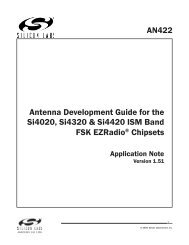C8051F326/7 - Silicon Labs
C8051F326/7 - Silicon Labs
C8051F326/7 - Silicon Labs
You also want an ePaper? Increase the reach of your titles
YUMPU automatically turns print PDFs into web optimized ePapers that Google loves.
12.6. Function Addressing<br />
<strong>C8051F326</strong>/7<br />
The FADDR register holds the current USB0 function address. Software should write the host-assigned<br />
7-bit function address to the FADDR register when received as part of a SET_ADDRESS command. A new<br />
address written to FADDR will not take effect (USB0 will not respond to the new address) until the end of<br />
the current transfer (typically following the status phase of the SET_ADDRESS command transfer). The<br />
UPDATE bit (FADDR.7) is set to ‘1’ by hardware when software writes a new address to the FADDR register.<br />
Hardware clears the UPDATE bit when the new address takes effect as described above.<br />
USB Register Definition 12.7. FADDR: USB0 Function Address<br />
R R/W R/W R/W R/W R/W R/W R/W Reset Value<br />
Update Function Address 00000000<br />
Bit7 Bit6 Bit5 Bit4 Bit3 Bit2 Bit1 Bit0 USB Address:<br />
0x00<br />
Bit7: Update: Function Address Update<br />
Set to ‘1’ when software writes the FADDR register. USB0 clears this bit to ‘0’ when the new<br />
address takes effect.<br />
0: The last address written to FADDR is in effect.<br />
1: The last address written to FADDR is not yet in effect.<br />
Bits6–0: Function Address<br />
Holds the 7-bit function address for USB0. This address should be written by software when<br />
the SET_ADDRESS standard device request is received on Endpoint0. The new address<br />
takes effect when the device request completes.<br />
Rev. 1.1 97


